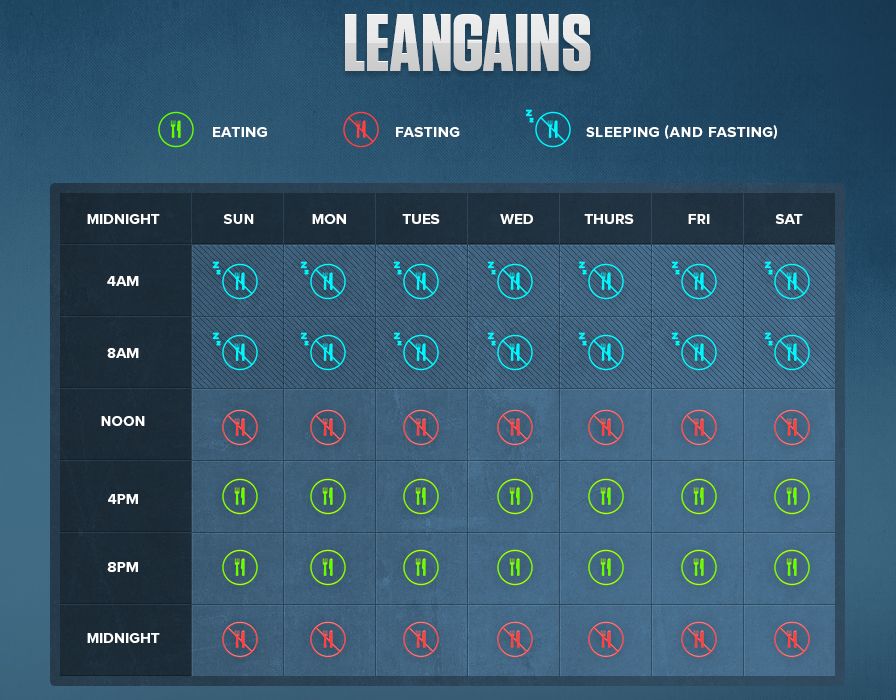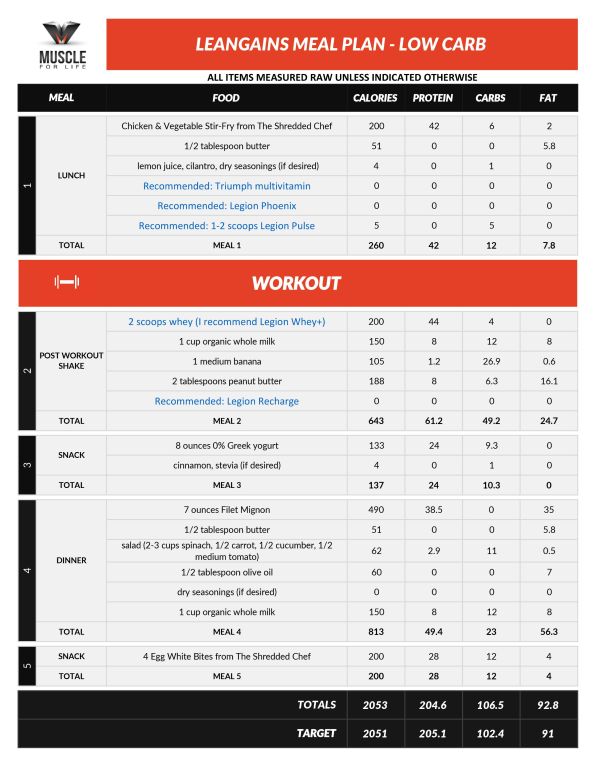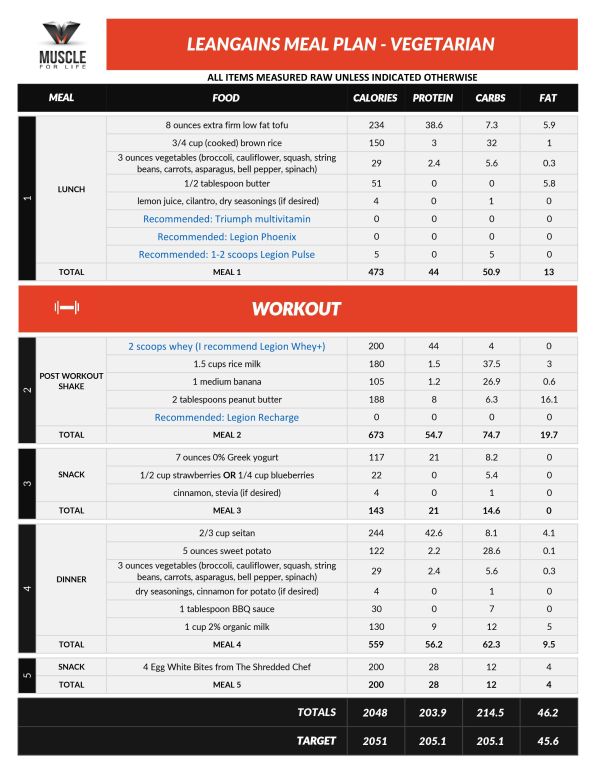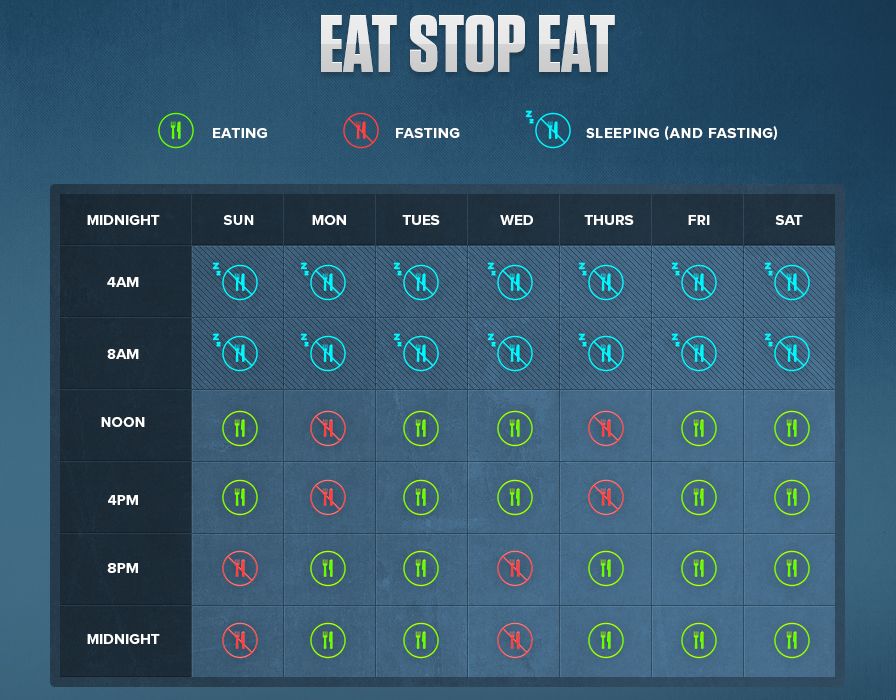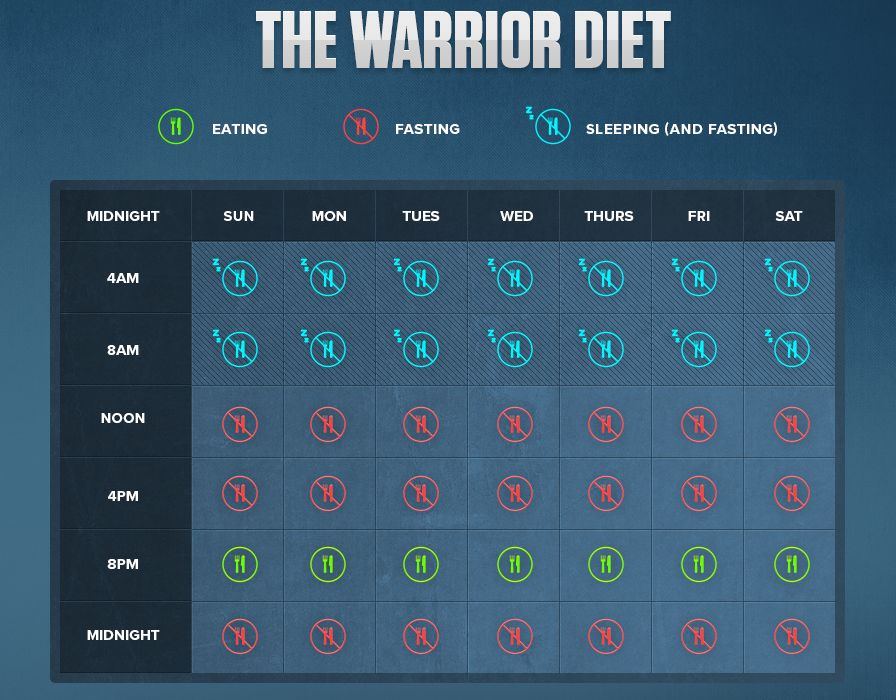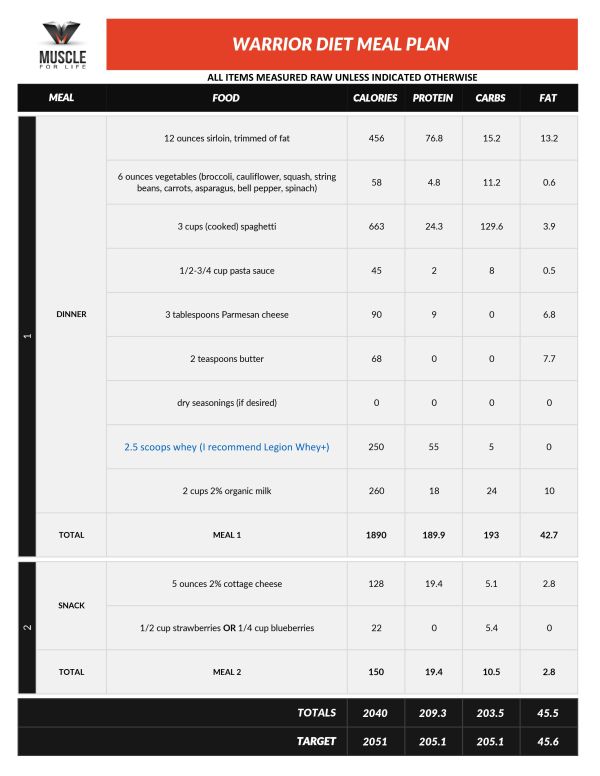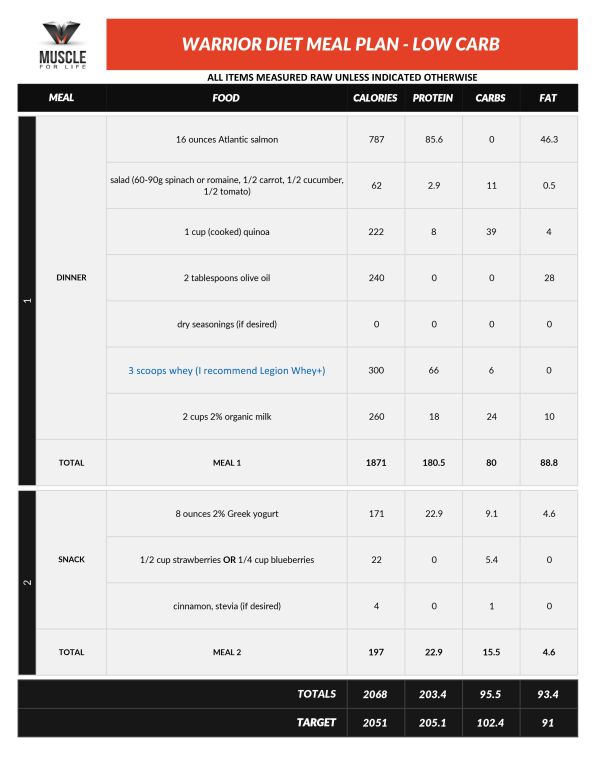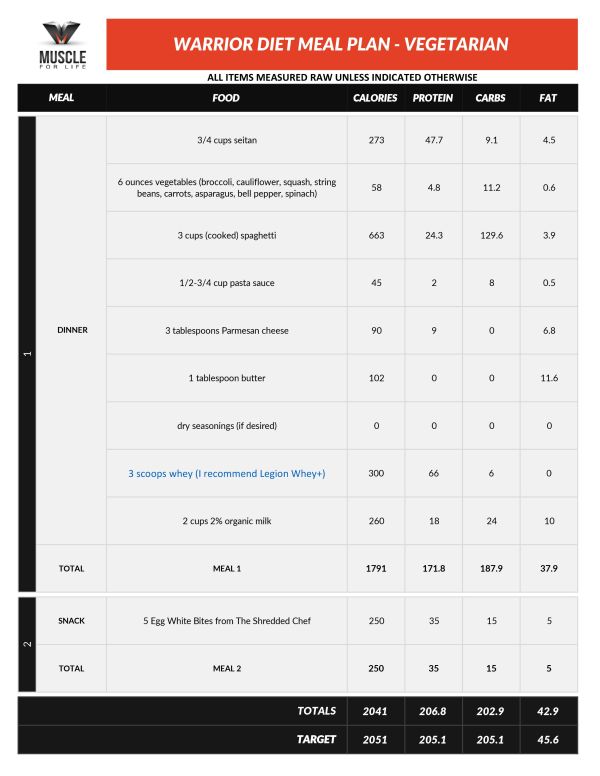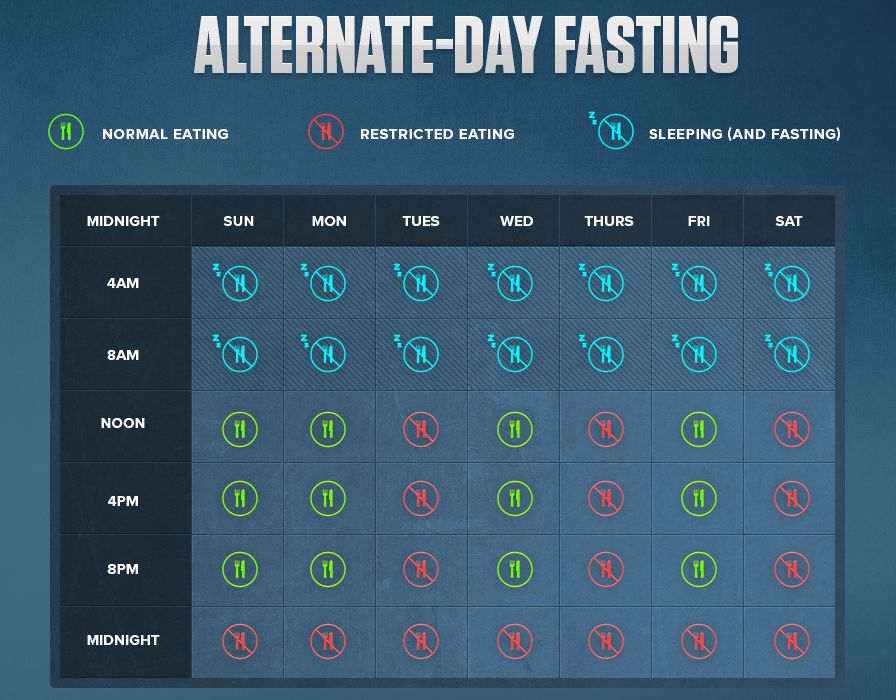When I first heard about intermittent fasting, I thought it sounded stupid.
And bad.
And really uncomfortable.
I mean…eating nothing for 16, 18, 24, or even 36 hours and then “feasting”?
That’s going to help you lose weight, build muscle, improve mental performance, age slower, and prevent sickness?

If that doesn’t sound like another fad starvation diet destined to sweep the airwaves and bestseller lists and then nosedive into obscurity, I don’t know what does.
Well, I was wrong.
Intermittent fasting isn’t stupid or bad and while some people find it uncomfortable, it doesn’t have to be.
In fact, the scientific underpinnings of intermittent fasting have helped advance our general understanding of the human metabolism and shatter quite a few long-standing diet myths.
That said, intermittent fasting isn’t the holy blessing that many Clickbank carpetbaggers would have you believe.
It’s not the “secret” to losing belly fat rapidly or “body recomposition,” it’s probably not going to increase your testosterone levels, and it’s not going to keep you young forever.
It may help you lose fat faster and maintain your ideal body composition, though, and it may be beneficial to your health.
So, in this article, you’re going to learn what intermittent fasting is, how it works, several of the most popular intermittent fasting diets, and how to use them to build muscle or lose fat.
Let’s start at the top.
- What Is Intermittent Fasting?
- Is Intermittent Fasting Healthier Than Traditional Dieting?
- Is Intermittent Fasting Better for Weight Loss?
- Is Intermittent Fasting Better for Building Muscle?
- The Most Popular Intermittent Fasting Diets
- The Bottom Line on Intermittent Fasting
Table of Contents
What Is Intermittent Fasting?
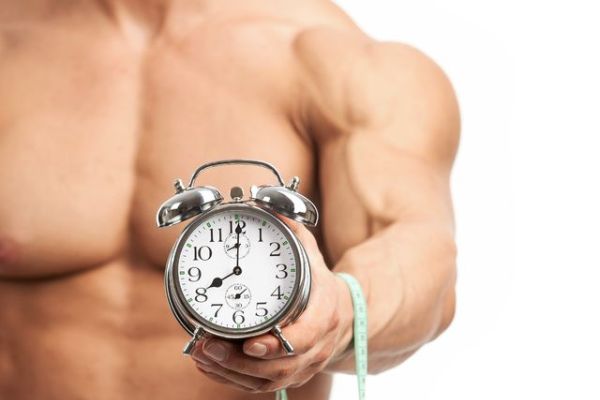
Intermittent fasting (or “IF,” as it’s commonly called) is kind of a misnomer.
It sounds like a diet wherein you fast (eat nothing for extended periods of time) at irregular intervals (intermittently), but most protocols have you fast on a regular schedule.
For instance, one popular IF diet (Leangains) has you fast for 16 hours per day and eat during the remaining 8 hours.
Another calls for 20 hours of fasting with a 4-hour feeding window, and yet another entails alternating between days of normal and no eating whatsoever.
Now, I mentioned that fasting involves eating nothing for long periods of time, but it’s a bit more than that…
What Is Fasting?

When you eat food, it gets broken down into various molecules that your cells can use, and these molecules are released into your blood.
Insulin is released as well, and its job is to shuttle the nutrients into the cells.
Depending on how much food you eat in a meal, your insulin levels can remain elevated for several hours (anywhere from 3 – 6+).
When your body is digesting and absorbing what you’ve eaten, it’s in a “fed” or “postprandial” state (prandial means “having to do with a meal”).
Once it has finished processing and absorbing the meal, insulin levels drop to a “minimum” low (or “baseline”) level, and your body enters a “fasted” or “postabsorptive” state.
Every day your body moves between “fed” and “fasted” states, and the purpose of intermittent fasting is to extend the amount of time spent fasting.
Most people start eating food around 8 AM and stop around 9 PM, with at least a few hours in between each meal.
That is, they eat food intermittently for about 13 hours and then eat nothing for about 11 hours, with a portion of those hours spent in a truly fasted state (the fasting doesn’t technically begin until the final meal of the day has been processed and insulin levels have dropped).
With this traditional setup, the average person probably spends an average of about 6 or 7 hours per day in a fasted state.
Intermittent fasting flips this around, allowing you to easily double the amount of hours that you fast.
Why bother, though? What’s so special about fasting?
The Benefits of Fasting

All fad diets have one simple thing in common:
They turn on one core idea that is supposed to “change everything.”
Carbohydrate restriction, for example. Or eating as (marketers claim) our ancient ancestors ate. Or avoiding a mostly harmless protein in grains.
Hence my initial skepticism with intermittent fasting, which puts fasting in the spotlight.
Well, it turns out there is something special about fasting.
For example, fasting triggers a physiological process known as “autophagy,” which deals with the destruction of cells in the body.
Autophagy plays a crucial role in maintaining muscle mass and neutralizing some of the degenerative aspects of aging. In fact, it’s the primary mechanism behind the anti-aging effects of calorie restriction.
Studies also show that fasting can also reduce systemic inflammation, reduce oxidative damage, improve insulin sensitivity, and raise growth hormone levels.
In many ways, fasting allows your body to “clean house” and works almost like a systemic “reset” button. And the purpose of intermittent fasting is to push that button more frequently.
So, there’s no question that fasting is healthy.
Does that mean that intermittent fasting is inherently healthier than traditional dieting, though?
Is Intermittent Fasting Healthier Than Traditional Dieting?

I don’t think we have a final answer to this question yet, but research shows it’s probably not as wondrous as many people would have you believe.
For example, let’s look at a large systematic review of intermittent fasting conducted by scientists from The University of Sydney.
After analyzing 40 studies on intermittent fasting (with 12 comparing it directly to traditional, continuous-energy dieting), researchers found no significant benefits related to body composition, fat loss, insulin sensitivity, or hormones.
That is, IF looks better on paper than it actually plays out.
Let’s not also forget about the nourishing power of exercise, either, which provides many of the health benefits associated with intermittent fasting.
The question I’d like to see addressed in research is: is intermittent fasting plus regular exercise and proper dieting any better than traditional dieting under the same circumstances?
The reason for this is exercise is so good for your body that it can compensate for all kinds of dietary sins.
The fastidious “clean eater” that doesn’t exercise is, in time, much more likely to have health problems than the freewheeling “flexible dieter” that spends a few hours per week in the gym.
Is Intermittent Fasting Better for Weight Loss?

If you’re reading this article, there’s a good chance you want to lose weight and are hoping intermittent fasting can make it easier.
Well, I mentioned above, research clearly shows that intermittent fasting isn’t inherently better for weight loss than traditional dieting.
That said, some people do lose weight faster on an intermittent fasting diet than a traditional one.
The reason for this is simple: IF helps them control their caloric intake and prevent overeating. This, in turn, helps them lose weight faster.
“What about losing fat, though?” you might be wondering. And you’re right–that’s an important distinction to make.
We don’t want to simply lose weight–we want to lose fat and not muscle.
And that brings us to the biggest criticism leveled against intermittent fasting in the context of bodybuilding…
Can Intermittent Fasting Cause Muscle Loss?

If this style of dieting sounds like a great way to disintegrate lean mass, I understand.
I used to think the same thing.
In fact, I once believed that I had to eat protein every few hours or I would lose muscle and wreck my metabolism.
Well, it turns out that meal frequency has very little importance in the overall scheme of things.
When we’re talking muscle growth, how often you eat food (and protein) isn’t nearly as important as how much you eat every day.
To understand why, let’s look at what needs to happen for your body to burn muscle for energy.
Glucose, or blood sugar, is a great source of energy for your cells and organs. Your brain particularly likes it, using upward of 25% of total body glucose.
The easiest way to give your body glucose is to eat carbs, but your body can also create it out of other substances.
- One of these substances in glycogen, which is created out of glucose and stored in the liver and muscles.
- Another source is body fat, which contains a substance glycerol that can be converted into glucose.
- Finally, there’s amino acids found in protein and muscle, which too can be converted into glucose.
Here’s what many people don’t know about the last bit:
The process whereby amino acids are converted into glucose is known as “gluconeogenesis,” and it doesn’t occur with any magnitude until the liver’s glycogen stores have been depleted.
That is, your body won’t turn to muscle tissue for glucose until the liver runs out of glycogen.
The average person’s liver stores about 100 grams of glycogen, which will fuel the body for anywhere from 6 to 24 hours of fasting, depending on physical activity level, basal metabolic rate, and more.
For example, in this study, gluconeogenesis was responsible for about 50% of glucose maintenance at the 16-hour mark of fasting, and 100% at the 28-hour mark.
This is why many intermittent fasting protocols designed for athletes and bodybuilders don’t have you fasting for more than 16 hours.
The bottom line is the body wants to preserve muscle, not burn it, and under normal circumstances, no serious muscle loss can occur until you’ve fasted for 12 to 16+ hours.
The caveat is in the case of doing intense physical activity while fasting, which can dramatically increase the rate at which glycogen is pulled from the liver and increase muscle breakdown rates.
“What about fasted training, then?” you’re wondering?
We’ll get to that in a minute…
Does Intermittent Fasting Force the Body into “Starvation Mode”?

Have you heard this before?
“If you go too long without eating, your body will think it’s being starved and rapidly store fat when you eat again.”
This is the “starvation mode” theory, and it’s a complete fabrication.
In one study, basal metabolic rate didn’t decline until 60 hours of fasting, and the reduction was a paltry 8%. Other research shows that the metabolism actually speeds up after 36 to 48 hours of fasting.
This might seem counterintuitive, but if we look at it from an evolutionary perspective, it makes sense.
If we haven’t eaten in quite some time, what does our body want us to do?
Go find food, of course.
And how can it prod us to go do that?
By flooding the tubes with adrenaline and noradrenaline, which sharpen our minds and make us want to go move around and, incidentally, increase our basal metabolic rate.
The real “starvation mode” begins after about 3 days (72 hours) of not eating, at which point muscle become the body’s primary source of energy.
Even then, though, the body takes measures to halt further muscle loss because of muscle’s vital role in keeping us strong, functional, and resistant to disease.
So, don’t worry about fasting and the specter of starvation.
No sensible IF protocol–like the ones we’ll discuss soon–is going to cause any harm to your muscles or metabolism.
Does Fasted Exercise Help You Lose Weight Faster?

Most intermittent fasting diets recommend that you do some sort of fasted exercise.
That is, exercise when insulin levels are low and body fat is the primary source of energy.
Well, while there’s nothing wrong with training in a fed state–any exercise burns energy, which supports your weight-loss efforts–research shows that training in a fasted state offers unique fat loss benefits.
- Studies show that exercising in a fasted state increases both lipolysis and fat oxidation rates.
What this means is that when you do your exercise fasted, your body is able to both mobilize and burn more fat than when fed.
- Research shows that blood flow in the abdominal region is increased when you’re in a fasted state.
One of the reasons belly fat is so hard to lose is impaired blood flow, and fasted training helps overcome this.
There is a major downside to fasted training, however: it increases muscle breakdown rates.
This is undesirable because if muscle breakdown rates are too high, your body won’t be able to keep up with repair and you can lose lean mass. (And this is especially true when you’re restricting calories for fat loss.)
Another downside to fasted exercise is lackluster workouts.
Many people find they have less energy and focus during fasted training and aren’t able to maintain their normal level of physical and mental intensity.
The bottom line is fasted training is good for losing fat faster, but not so good for maintaining muscle and enjoying your workouts.
Fortunately, you can change this with effective supplementation.
First, you can neutralize the muscle loss with β-Hydroxy β-Methylbutyrate (also known as HMB).
This is a substance formed when your body metabolizes leucine, which is an amino acid that directly stimulates protein synthesis.
HMB is often sold as a muscle-building aid, but the research behind these claims is shaky at best due mainly to design flaws and funding biases.
There is one benefit of HMB that’s well established, however: it’s an extremely effective anti-catabolic agent.
That is, it’s very good at preventing muscle breakdown, which means you will recover faster from your workouts and experience less muscle soreness.
HMB also has no effect whatsoever on insulin levels, which means it won’t break your fasted state like food.
These properties make HMB perfect for use with fasted training.
Its powerful anti-catabolic effects and nil impact on insulin levels allow you to reap all the fat loss benefits of fasted exercise without the problems related to protein metabolism.
It’s also worth noting that HMB is superior to leucine in suppressing muscle breakdown because it’s more anti-catabolic than its “parent” amino acid.
This means it’s also more effective for fasted training than branched-chain amino acid (BCAA) supplements, which rely primarily on leucine for their anti-catabolic effects.
Clinically effective dosages of HMB range between 2 and 3 grams, and that’s what you’ll find in my pre-workout fat burner FORGE:
FORGE also contains a clinically effective dosage of yohimbine, which, when combined with fasted exercise, accelerates fat loss (and the loss of “stubborn fat” in particular) and improves workout performance.
The Bottom Line on Intermittent Fasting and Weight Loss
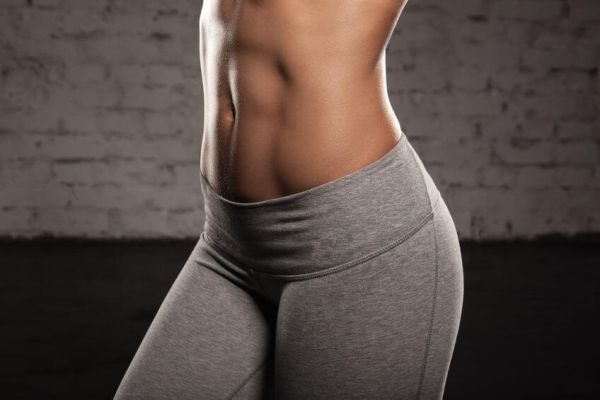
Studies show that when calorie deficits are matched, people lose weight equally well on a traditional diet as an intermittent fasting protocol.
That said, just because intermittent fasting confers no metabolic benefits doesn’t mean it can’t help you in other ways.
For example, if a diet makes you less hungry than usual or crave fewer sweets, you’re probably going to see better results with it.
In many ways, the best diet is the one you can stick to.
Well, there is evidence that a diet with a lower meal frequency like IF can help with controlling your appetite. There’s evidence to the contrary as well, so all this means is you’ll have to try it for yourself and see how your body responds.
Personally, I prefer a traditional diet structure of eating light meals every few hours and one or two larger meals at night.
I do skip breakfast a couple days per week, though, on days that I’m not lifting (I train early in the morning and follow it with a post-workout shake).
Whether this habit of mine has any health benefits is uncertain, but I do enjoy how it feels and it lets me be a bit more flexible with my meals on my rest days, so that’s enough of a reason to do it.
Is Intermittent Fasting Better for Building Muscle?

There are quite a few fitness “gurus” that want you to buy (literally) into the idea that intermittent fasting is the best way to eat for building “lean muscle.”
In fact, many up the ante even further and promote it as the key to building muscle and losing fat at the same time.
Well, there’s evidence fasted training produces a larger anabolic response to a post-workout meal than fed training, but this isn’t proof that fasted training will actually yield more muscle growth over the long term.
One significant downside to fasted weightlifting is the fact that eating 50 to 60 grams of carbs before a workout is an easy way to boost performance.
And the better you can perform in your workouts, the more muscle and strength you can gain over time. This is one reason why I generally recommend fasted training for cutting but not bulking.
Here’s the bottom line:
Research shows you can build muscle with an intermittent fasting diet…but it’s not inherently better than a traditional diet.
So, as with fat loss, it boils down to your personal preferences.
The Most Popular Intermittent Fasting Diets

We’ve come to the final stop in our odyssey: how to actually follow an intermittent fasting diet.
Before we dive in, though, remember this:
No intermittent fasting diet can allow you to cheat or sidestep the rules of energy balance.
At the end of the day, regardless of how you structure your meals, how much you eat is going to determine your results.
It all boils down to calories and macros, and anyone that says otherwise is either ignorant or lying.
Thus, if you want to see results with intermittent fasting, you need to approach it like any other style of dieting.
You need to know and stick to your numbers and avoid the common mistakes that prevent people from losing weight effectively.
So, with that out of the way, let’s check out the most popular intermittent fasting diets.
Leangains
Leangains is an intermittent fasting protocol created by Martin Berkhan, and it’s the reason IF has gained so much acceptance in the world of bodybuilding.
Here’s how it works:
You fast for 16/14 hours (men/women) and eat in 8/10-hour (men/women) “feeding windows.”
Your fast begins after you’ve eaten your last meal of the day and ends with your first.
For example, if you’re a guy and eat your last meal at 9 PM, then you don’t eat again until 1 PM the next day. If you’re a girl, you break your fast two hours earlier, at 11 AM.
While fasting, you’re not supposed to eat any calories, but black coffee, zero-calorie sweeteners, diet soda, and sugar-free gum are permitted.
It’s also recommended that you maintain a consistent fasting and feeding schedule because it will help keep hunger under control.
You follow a high-protein diet.
This is vital for building and preserving muscle.
You eat more calories and carbs on training days than rest days.
This is known as calorie cycling and it can be useful for gaining muscle and strength while minimizing fat gain.
That sounds great, of course, but I feel calorie cycling is best suited to advanced weightlifters that are more or less happy with their overall development for reasons given here.
If you’re new to weightlifting or are still looking to maximize muscle growth, I recommend a more traditional “lean bulk” approach over calorie cycling.
Fasted training is optional.
Berkhan is a major advocate of fasted training but allows for a pre-workout meal before you train if you prefer training fed.
You should eat a large post-workout meal.
Regardless of whether you train fasted or fed, Berkhan recommends a very large post-workout meal (it should be the largest meal of the day).
He recommends that you eat 30 to 50% of your daily calories in this meal with a large amount of protein (50 to 100 grams).
The rest.
The program has a few more moving parts than what I’ve outlined above, so I recommend you just read Martin’s instructions in full to get the whole scoop.
Leangains Meal Plans
If Leangains sounds right for you, the next step is building some meal plans to follow.
These examples, which my team built as a part of our custom meal plan service, should help:
The Bottom Line on Leangains
Leangains was built specifically for weightlifters and people that care about their body composition, and is my personal favorite method of intermittent fasting.
Eat Stop Eat
Eat Stop Eat is a method of intermittent fasting that was created by Brad Pilon and it’s very simple:
- You fast for 24 hours once or twice per week.
- You can start your fasts when you like, but they must go for 24 hours.
They must be proper fasts, too–no food is allowed but, like Leangains, calorie-free beverages are okay.
If you can’t make it 24 hours without wanting to eat your face, start by fasting for as long as you can and gradually work toward the full 24 hours.
To make the fasting easier, Brad suggests that you start your fast while you’re busy and on a day where you have no social obligations that involve eating.
Furthermore, it’s important that you break your fast with a normal meal. You shouldn’t pig out to “make up for” the calories you didn’t eat during the fast.
Brad also recommends that you exercise regularly, and places special emphasis on weightlifting for improving body composition.
The Bottom Line on Eat Stop Eat
Eat Stop Eat allows you reap some of the health benefits of fasting and lose weight…
…if you can endure the long fasts…
…and don’t succumb to post-fast bingeing.
If you’re serious about weightlifting and gaining muscle and strength, though, or if you’re lean and looking to get really lean, I recommend Leangains instead.
The Warrior Diet
This is Ori Hofmekler’s protocol, as popularized by his book.
It revolves around “fasting” for 20 hours every day and eating the majority of your food in one large meal every night.
I say “fasting” because you’re allowed to eat a few small snacks of protein, fruit, and/or veggies throughout the day, which will elevate insulin levels and break the fasted state.
Furthermore, Hofmekler says you should start your big meal by eating vegetables, and then move to protein, and then fat. If you’re still hungry after eating fat, you can eat carbs.
The practical benefit of this is calorie control (you’re less likely to overeat this way versus starting your meal with a swan dive into a bowl of delicious carbs).
Hofmekler’s theory is that humans are programmed for night eating and we can optimize our health and body composition by following our genetics.
If we do this, he says, we can burn more fat, build more muscle, recover from our workouts better, enjoy better sleep, and more.
As you can guess, I think he’s grossly over-selling the benefits of the diet without sufficient scientific evidence to justify the hype.
Warrior Diet Meal Plans
I’m not a fan of the Warrior Diet, but if you want to give it a go, here are a few examples of how you might lay out meal plans for the Warrior Diet.
The Bottom Line on the Warrior Diet
I don’t recommend the Warrior Diet unless you really like eating one large meal every day.
And even if you do, I wouldn’t recommend it if you’re weightlifting regularly. Your workouts are going to suck. You may or may not get enough protein. You probably won’t get enough carbs.
Follow Leangains instead.
Alternate Day Fasting
Alternate-Day Fasting (ADF) is a simple method of intermittent fasting that has you alternate between days of normal and restricted eating.
On “normal” days, you eat more or less the amount of energy you burn (TDEE). On “restricted” days, you eat 20 to 25% of this amount (around 500 calories for most people).
Doing this allows you to keep your weekly caloric intake under expenditure, which results in weight loss.
The Bottom Line on Alternate Day Fasting
ADF can be great for overweight/obese people that are relatively sedentary, but really isn’t for fitness folk trying to build a great physique.
The main problems are you can’t eat enough protein on your low-calorie days and your workouts are going to be horrible.
Eat When You’re Hungry or When You Can

The simplest way to incorporate fasting into your diet is to allow your appetite and schedule dictate when you eat.
For instance, if you wake up and you’re not hungry, you don’t have to eat breakfast for the sake of it. Wait until you’re hungry.
Or if you find yourself stuck in a situation where the only food available is something you really don’t want to eat, skip the meal and make up the calories/macros later.
Remember that total daily intake (calories and macros) is what matters most. How you get there is of little importance.
So if you skip a meal where you had planned to eat, let’s say, 30 grams of protein, 70 grams of carb, and 20 grams of fat, you can just add those amounts to your later meals.
The Bottom Line on Intermittent Fasting

Like many fad diets, intermittent fasting is a victim of unreal hopes and expectations.
People are always hunting for the “magic bullet” for building muscle, losing fat, and getting healthy, and there are always marketers ready to oblige them.
It would be great if manipulating your eating schedule alone could deliver on all the promises made by IF advocates, but it can’t. Only an all-inclusive healthy lifestyle of proper exercise, diet, sleep hygiene, supplementation, etc. can.
So…if you’re a healthy adult that exercises regularly, whether you should do intermittent fasting boils down to how you like to eat and what best fits your lifestyle.
If you get too hungry to comfortably fast for long periods, stop trying to jam the square peg into the round hole. Find a meal frequency that works for you.
The same goes if you’re like me and don’t run into issues with hunger but your schedule doesn’t lend itself well to short feeding windows. Don’t try to stick to a diet that isn’t sustainable for you.
If, however, you enjoy the feeling of fasting or if it helps you control your caloric intake, or if you like a lower meal frequency or later eating times, then intermittent fasting might be perfect for you.
What’s your take on intermittent fasting? Have anything else to share? Let me know in the comments below!
+ Scientific References
- Миркин БГ. Alternate Day Fasting and Weight Loss. 2013:292-307. doi:10.1186/1475-2891-12-146
- Frecka JM, Mattes RD. Possible entrainment of ghrelin to habitual meal patterns in humans. Am J Physiol Gastrointest Liver Physiol. 2008;294(3):G699-707. doi:10.1152/ajpgi.00448.2007
- Trabelsi K, Stannard SR, Ghlissi Z, et al. Effect of fed- versus fasted state resistance training during Ramadan on body composition and selected metabolic parameters in bodybuilders. J Int Soc Sports Nutr. 2013;10(1):23. doi:10.1186/1550-2783-10-23
- Cermak NM, van Loon LJC. The use of carbohydrates during exercise as an ergogenic aid. Sports Med. 2013;43(11):1139-1155. doi:10.1007/s40279-013-0079-0
- Deldicque L, De Bock K, Maris M, et al. Increased p70s6k phosphorylation during intake of a protein-carbohydrate drink following resistance exercise in the fasted state. Eur J Appl Physiol. 2010;108(4):791-800. http://www.ncbi.nlm.nih.gov/pubmed/20187284. Accessed September 18, 2019.
- Harvie MN, Pegington M, Mattson MP, et al. The effects of intermittent or continuous energy restriction on weight loss and metabolic disease risk markers: a randomized trial in young overweight women. Int J Obes (Lond). 2011;35(5):714-727. doi:10.1038/ijo.2010.171
- Ohkawara K, Cornier M-A, Kohrt WM, Melanson EL. Effects of increased meal frequency on fat oxidation and perceived hunger. Obesity (Silver Spring). 2013;21(2):336-343. doi:10.1002/oby.20032
- (PDF) Ergogenic Effects of Yohimbine: Standardized Cycling… Ergogenic Effects of Yohimbine: Standardized Cycling Clinical Study. https://www.researchgate.net/publication/273061682_Ergogenic_Effects_of_Yohimbine_Standardized_Cycling_Ergogenic_Effects_of_Yohimbine_Standardized_Cycling_Clinical_Study. Accessed September 18, 2019.
- Ostojic SM. Yohimbine: the effects on body composition and exercise performance in soccer players. Res Sports Med. 14(4):289-299. doi:10.1080/15438620600987106
- Wilkinson DJ, Hossain T, Hill DS, et al. Effects of leucine and its metabolite β-hydroxy-β-methylbutyrate on human skeletal muscle protein metabolism. J Physiol. 2013;591(11):2911-2923. doi:10.1113/jphysiol.2013.253203
- Wilson JM, Lowery RP, Joy JM, et al. β-Hydroxy-β-methylbutyrate free acid reduces markers of exercise-induced muscle damage and improves recovery in resistance-trained men. Br J Nutr. 2013;110(3):538-544. doi:10.1017/S0007114512005387
- Rowlands DS, Thomson JS. Effects of beta-hydroxy-beta-methylbutyrate supplementation during resistance training on strength, body composition, and muscle damage in trained and untrained young men: a meta-analysis. J strength Cond Res. 2009;23(3):836-846. doi:10.1519/JSC.0b013e3181a00c80
- Kimball SR, Jefferson LS. Signaling pathways and molecular mechanisms through which branched-chain amino acids mediate translational control of protein synthesis. J Nutr. 2006;136(1 Suppl):227S-31S. doi:10.1093/jn/136.1.227S
- Pitkanen HT, Nykanen T, Knuutinen J, et al. Free Amino Acid Pool and Muscle Protein. Sport Med. 2003;35(5):784-792. doi:10.1249/01.MSS.0000064934.51751.F9


